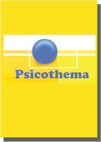Abstract
lingüísticas demostraron poseer una elevada consistencia interna y un aceptable grado de equivalencia entre sus dos formas paralelas, si bien los resultados americanos fueron significativamente más elevados que los españoles. En ambas muestras, el análisis de componentes principales reflejó cuatro dimensiones: Déficit atencional, Hiperactividad/Impulsividad, Ansiedad generalizada y Conducta opositora/provocativa; el grado de congruencia de las estructuras factoriales en las dos muestras consideradas se analizó mediante el coeficiente de Tucker, resultando ser estadísticamente similares. Comparison between the results obtained on the ADHD (Attention Deficit Hyperactivity Disorder) sca le in an American sample and a Spanish sample of adults. The present work focuses on the comparison between the psychometric properties infered from the scores obtained by an American sample and a Spanish sample of adults on the ADHD (Attention Deficit Hyperactivity Disorder) scale. The scale is available in English and Spanish and has two parallel forms. Each of these forms consists of five subscales: Inattention, Hyperactivity, Impulsivity, Generalized Anxiety and Oppositional/Defiant Disorder. Each item of the scale evaluates a specific type of behavior relating to a criterion of psychiatric conduct relevant for the diagnosis according to DSM-IV. Both linguistic versions showed to have a high internal consistency and an acceptable le vel of equivalence between their two parallels forms, even though the American results were significantly higher than the Spanish results. In both samples, the analysis of principal components reflected four dimensions: Inattention, Hyperactivity/Impulsivity, Generalized Anxiety and Oppositional Defiant Disorder; the level of congruence between the factor structures of the two samples taken into consideration was analyzed by means of theTucker coefficient, proving to be statistically equivalent.Downloads
Download data is not yet available.
